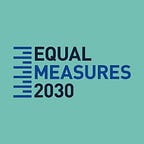Hope for gender equality exists — if you know where to look
By Alison Holder, Director of Equal Measures 2030
Many of those fighting for the rights of girls and women are rightly worried about the threats to women’s rights happening now at a global scale. In the words of the new UN Secretary-General, “In these troubled times, as our world becomes more unpredictable and chaotic, the rights of women and girls are being reduced, restricted and reversed.”
While it’s easy to find anger, despair and a fear that we’re rolling back instead of progressing forward towards a more gender equal world, I’d also ask everyone to look again. Because you can also find hope: girls and women are activating and organizing like never before.
This week, governments and advocates for women’s rights are gathering in New York for the Commission on the Status of Women — an annual two-week forum designed to advance women’s rights globally. Just months ago, nearly 5 million people marched across all seven continents to promote women’s rights. Private sector leaders are speaking out about the importance of empowering women for their bottom lines. Debates about feminism are moving from the fringes into the spotlight. We now have more data and information about who’s being left behind and why. And, crucially, 192 countries have signed up to a plan (also known as the “Global Goals”) that contain the promise that we’ll be living in a gender equal world by 2030.
The promise is there. It’s up to us to hold our leaders — and ourselves — to it.
But how will we know if our governments are really doing enough to shift the needle and come close to reaching the ambition of the Global Goals? Do women’s movements and rights advocates have the tools they need — including data and evidence about what’s changing, how fast and for whom?
It is often said that we measure what matters, and what matters gets measured. Women do 2.5 times more unpaid household and care work than men.(1) What does it say to girls and women that this work is not captured at all by Gross Domestic Product, the standard metric of a country’s ‘worth’? What does it say to girls and women that most countries have no idea how tax or public spending decisions will affect them?(2) Or that we can’t really measure how power and resources are divided within their families because usually men take on the role of “head of household” when they answer surveys? Or that only 13 per cent of countries dedicate a budget towards gender statistics?(3)
A lack of data on women and girls has hampered the ability to influence policy, track progress and demand accountability. Thankfully, the danger of having no data or bad data about girls and women is increasingly being recognized. Data2X, announced by Hillary Clinton in 2013, has been working to improve the quality, availability and use of gender data to advance gender equality and women’s empowerment. UN Women recently launched a flagship program called ‘Making Every Woman and Girl Count’ to improve the production, accessibility and use of gender statistics in countries. And in May last year, the Bill & Melinda Gates Foundation announced a $80 million commitment to close gender data gaps and accelerate progress for women and girls.
These are essential parts of the puzzle. But facts don’t speak for themselves. Just having data isn’t enough. We can’t fool ourselves into thinking that if only decision makers knew the scale of the problem, they would be moved to act.
Putting credible data into the hands of women’s movements and rights advocates, and into the hands of decision makers willing to take real action, is the missing link to ensure evidence really fuels progress towards greater gender equality.
This is the exact premise that underpins our new global partnership, Equal Measures 2030, an independent civil society and private sector-led partnership officially being launched this week.
Equal Measures 2030 envisions a world where gender equality is achieved, and where every girl and woman counts and is counted.
The partnership is a joint effort of: Asia-Pacific Resource and Research Centre for Women (ARROW), Bill & Melinda Gates Foundation, Data2X, the African Women’s Development and Communication Network (FEMNET), International Women’s Health Coalition, KPMG International, ONE Campaign, Plan International and Women Deliver.
These nine founding partners from across civil society and the private sector are committed to fueling progress towards gender equality. We do this by making sure girls’ and women’s movements, rights advocates and decision makers have easy-to-use data and evidence to guide efforts to reach the Global Goals by 2030 and leave no one behind.
Amid all the recent talk about “alternative facts” and a “post-truth” world, the partners in Equal Measures 2030 intend to create social and political change towards a gender equal world the good, old fashioned way: by fueling women’s movements and rights advocates with data and evidence, galvanizing public action, holding decision makers to account, and using evidence to help them prioritize when they’re keen to make real change.
Virtually every world leader has committed to achieving gender equality by 2030 and virtually none of them are taking sufficient steps to make it happen.
As Amina J. Mohammed, the highest ranking woman in the United Nations, said last week on International Woman’s Day, “Women’s rights and opportunities are consistently neglected and even under threat in all regions… Just look around at who is sitting in governments and boardrooms. Do we see equality?”
By supporting movements of women’s and rights advocates, galvanizing pressure and support from citizens more broadly, and undertaking smart, evidence-based change strategies we can ensure the decision makers from the 192 countries that signed on to the Global Goals can and will deliver on their commitments by 2030. Equal Measures 2030 is ready to play its role in making that happen — will you join us?
